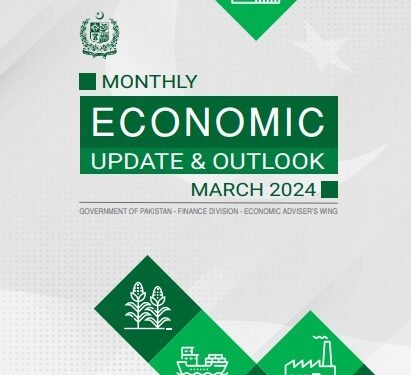ISLAMABAD, Mar 29 (APP):The country’s economic and financial position continues to improve with each passing month of the current fiscal year, attributed to prudent policy management and the resumption of inflows from multilateral and bilateral partners, finance ministry said in a recent report.
According to monthly Economic Update and Outlook for March, Pakistan reached a Staff-Level Agreement in its final review successfully concluding the International Monetary Fund’s (IMF) Stand-By Arrangement (SBA) program and securing a disbursement of $1.1 billion.
The ongoing efforts in policy and reform are easing out pressures on the gross financing needs, which has been intensified by increased external and domestic financing demands and an uncertain external environment. These positive developments have led to a sustained economic recovery and an uplift in the country’s overall economic confidence.
In real sector, agriculture outlook is promising, it says adding in Rabi season 2023-24, the wheat sowing has surpassed the target of 8.998 million hectare. The farm inputs also showcased an impressive growth in FY2024 with tractor production and sales up by 68.6 percent and 67.6 percent, respectively. Agriculture credit disbursement also rose by 34.7 percent to Rs 1,279.4 billion.
The Large Scale Manufacturing (LSM), observed a marginal decline of 0.5 percent during July-January FY2024, compared to a contraction of 2.7 percent last year. However, LSM output increased YoY by 1.84 percent in January 2024 when compared with January 2023. During July-January FY2024, 12 out of 22 sectors witnessed positive growth.
Headline inflation is on a downward trajectory; it dropped to 23.1 percent in February 2024 from 31.5 percent in February 2023. To reduce the inflationary impact, the federal government has provided the Ramadan Relief Package of Rs 12.5 billion, targeting low-income groups with food subsidies through various measures.
On the fiscal front, the primary surplus increased to Rs 1939 billion during July-January FY2024 from Rs 945 billion last year. The fiscal deficit during July-January FY2024, however increased to 2.6 percent of GDP as compared to 2.3 percent recorded last year.
The government is putting all its efforts to ensure prudent fiscal management through cautious expenditure and effective resource mobilization.
Current Account posted a deficit of $1.0 billion for July-February FY2024 as against a deficit of $ 3.9 billion last year, with largely reflecting an improvement in trade balance. In February 2024 current account posted a surplus of $ 128 million as against a deficit of $ 50 million same period last year.
Year-on-Year Exports increased by 16.2 percent to $ 2.6 billion in February 2024 as compared to $ 2.2 billion in February 2023 owing to ease in imports restriction and exchange rate stability which resulted in smooth supply of raw material for export-oriented industries.
The YoY imports also increased by 10.2 percent to $4.3 billion in February 2024 as compared to $3.9 billion same month last year.
The Foreign Direct Investment (FDI) witnessed an inflow of $ 131.2 million in February 2024 compared to an outflow of $ 173 million in last month. Remittances also show an upward trend, it increased by 13.0 percent in February 2024 ($ 2.2 billion) as compared to February 2023 ($ 1.9 billion).
SBP has maintained the policy rate at 22 percent on 18th March, 2024 – due to susceptible inflation outlook to risks amidst elevated inflation expectations. During 01st July–01st March, FY24 money supply (M2) registered growth of 3.8 percent (Rs 1192.1 billion) compared 1.14 percent growth (Rs 313.9 billion) in last year.
To maintain the policy and reforms, efforts are vital to entrench economic and financial stability during last quarter of on-going fiscal year. Moreover, sustaining the pace of external inflows to meet upcoming gross financing needs and external sector stability is inevitable.
According to the report, sustainable economic recovery requires continuation of fiscal consolidation and prudent policy stance, timely and adequate financial inflows to meet gross financing needs and external sector stability.



 Pakistan Rupee Exchange Rate
Pakistan Rupee Exchange Rate





